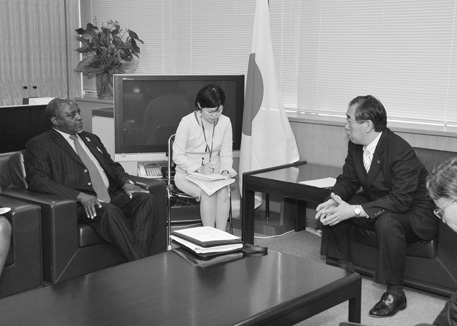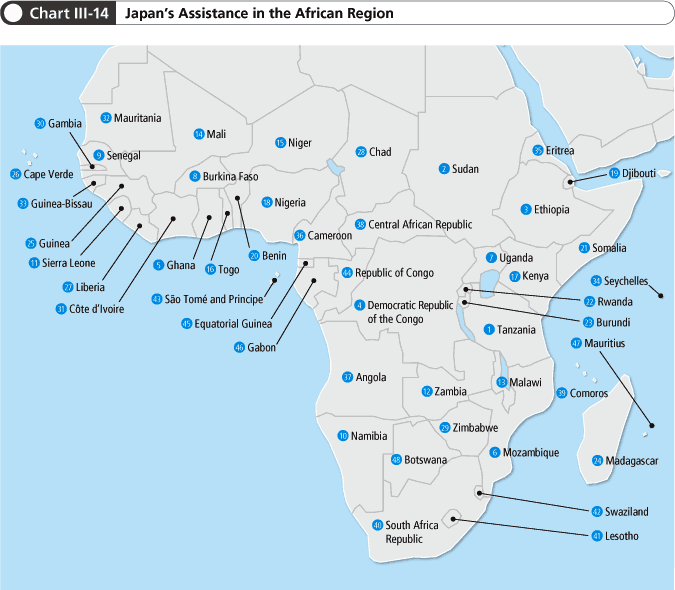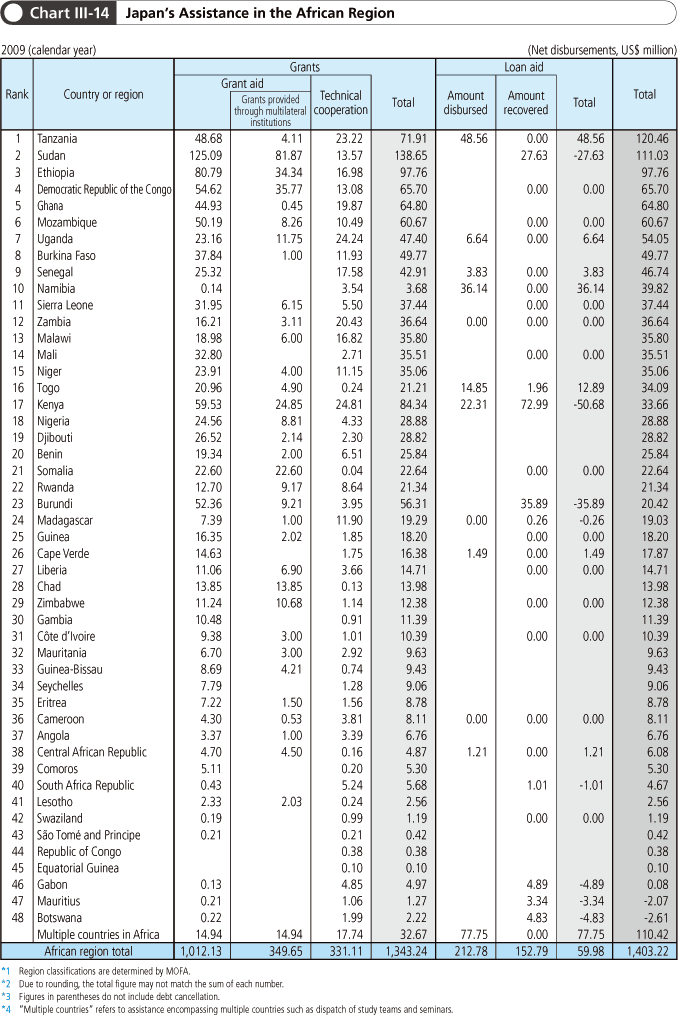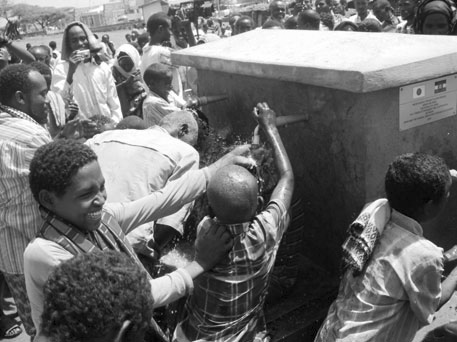Japan's Official Development Assistance White Paper 2010
4. Africa (Sub-Sahara)
Africa, in particular the Sub-Saharan African region located in the south of the Sahara Desert, continues to face serious poverty problems. The majority (33 of the 48 countries) of sub-Saharan countries in this region are considered least developed countries (LDCs), where nearly half of the population lives below the poverty line (approximately US$1 per day). In addition, many countries in the region have serious problems that hinder development, including civil war and conflicts, refugees, famine resulting from drought, and epidemics of infectious diseases such as HIV/AIDS, requiring a significant amount of aid from the international community. Even when looking at discussions taking place in venues such as the United Nations Security Council and G8 Summits, it is apparent that these types of problems in Africa are of critical interest to the international community.
At the same time, Africa boasts copious natural resources and a beautiful natural environment, and thereby possesses great potential for economic growth through trade and investments as well as the promotion of tourism. Japan must continue to make appropriate contributions as a responsible member of the international community in order to assist Africa in achieving sustainable economic growth and to reduce poverty.

State Secretary for Foreign Affairs Takeaki Matsumoto holding a meeting with Minister of Foreign Affairs and International Cooperation Phandu Tombola Chaka Skelemani of Botswana
<Japan’s Efforts>
Japan has proactively cooperated in undertakings led by African countries to address development issues through the Tokyo International Conference on African Development (TICAD), which bases itself on the fundamental principle of self-help efforts (ownership) conducted by African countries and cooperation by the international community (partnership). In May 2008, which marks 15 years since TICAD was launched in 1993, TICAD IV was held in Yokohama. In addition, in May 2010, the second TICAD ministerial-level follow-up meeting was held in Arusha, Tanzania. At this meeting, Japan once again indicated its resolve to uphold the promises it had announced at TICAD IV without fail, in response to which the other countries praised the degree to which the promises had been fulfilled. What is more, at the G8 Muskoka Summit in June, Japan continued to introduce the results of the follow-up meeting. At the same time, it also communicated that it would double ODA to Africa, which was one of its pledges, while also strengthening assistance for the achievement of MDGs that are important to Africa.
●For Japan’s support through TICAD Processes, see Section I, Chapter 3, Initiatives through the TICAD Process.
Japan also contributes to initiatives to achieve peace and stability in the African region. For example, assistance to Sudan was taken up as one of the priority areas in TICAD IV. Moreover, assistance for the ”consolidation of peace” that Japan emphasizes as an important pillar of its African policy serves as an example of this (Note 34). At the Third Sudan Consortium Conference held in Oslo in 2008, Japan announced assistance of US$200 million for the immediate future, which was to be added on top of its assistance up to that point. This assistance bears in mind: (1) the balance between Southern and Northern Sudan, (2) transitioning from humanitarian assistance to reconstruction and development assistance in its assistance for Southern Sudan, and (3) reducing regional disparities. As of August 2010, assistance of approximately US$220 million had been provided. In particular, the referendum inquiring issues like the independence of Southern Sudan scheduled for January 2011 represents the culmination of the process of fulfilling the Comprehensive Peace Agreement (CPA). Taking this into consideration, Japan provided about US$8 million in emergency grant aid for this referendum in support of the consolidation of peace in Sudan, ahead of the international community. Japan also proactively collaborates with international organizations and Japanese NGOs on measures like assistance for the return and reintegration of refugees, activities to clear landmines and unexploded ordnance and education for avoiding these explosives, medical assistance such as measures to combat infectious diseases in children, and food aid.
Notes:
(34) A civil war between the north and the south has persisted in Sudan since 1983. But a full-scale process for peace has been proceeding apace, as evidenced by the conclusion of the Comprehensive Peace Agreement (CPA) in January 2005 and the promulgation of an interim constitution. Yet scars from the civil war still remain, such as the internally displaced persons which number up to some 5 million people, the destruction of economic and social infrastructure, the proliferation of weapons and landmines, and the presence of a great many former soldiers. What is more, the activities of armed anti-government insurgents continue in the western Darfur region which, together with the government’s suppression activities, serve as barriers to the development and stability of the region.


●Ethiopia: Project for Water Supply in Afar Region
Located about 250 km to the northeast of Ethiopia’s capital city of Addis Ababa, the Afar Region is an area with scarce water resources that lies entirely within a desert zone. When Japan decided on the assistance project in 2007, the water supply rate for Ethiopia as a whole was roughly 31%, but in the Afar Region this was only 17%. In areas all over the region, women and children devoted a huge amount of effort to securing water, and there were outbreaks of health hazards due to the unsanitary water. Japan excavated and repaired wells in nine villages in the Afar Region, laid water transmission and distribution pipes, and installed a total of 28 public water faucets. This has reduced the burden of drawing water on women and children, and has made it possible for residents to have easy access to sanitary drinking water.

People from the Afar Region using one of the installed public water faucets
